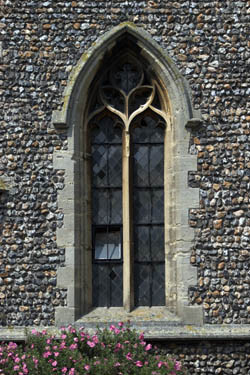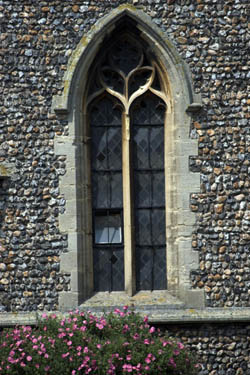Sigma 80-400mm f/4.5-5.6 EX APO OS DG
This mouthful of a lens is Sigma’s offering in the popular long telephoto range that incorporates a system for overcoming camera shake, this one being called OS (Optical Stabilisation) We take a look at how it performs against some venerable opposition.
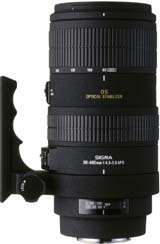 Specification
Specification
- Focal length 80-400mm
- Max aperture f/4.5-5.6
- Construction 20/14 elements/groups
- Closest focus 1.8m
- Filter size 77mm
- Weight 1.75kg
- Dimensions 95x192mm dia/length
- Hood Supplied
- Mount Sigma AF, Canon AF, Nikon AF
- Price (SRP) £999.99
Build and handling
The lens is supplied in a padded pouch, which at first seems a little oversized. On inspection, this is to accommodate the large, supplied; mounting foot and hood but still provides adequate protection.
The lens sports the standard two control rings, on this occasion the rear ring is the manual focus control while the forward ring is the zoom control. Both are nicely torqued. Two switch panels adorn the left side of the lens, the front one being a zoom lock for safe storage and carrying while the rear one, containing two switches, controls the AF/MF and the OS system.
The OS switch has three poSitions, off, 1 and 2. The first (1) position controls shake in both planes while the second (2) ignores horizontal movement and just compensates for vertical movement, for instance while panning.
When zoomed to the full 400mm reach, the front element extends out of the barrel by some 85mm on a single trombone but this shows absolutely no lateral movement whatsoever. A good sign.
Autofocus, although not by Sigma’s HSM system (Hypersonic motor) is both quick and accurate as well as being fairly quiet although not completely silent. The AF can be overridden manually without switching the AF off and the torque remains the same in both modes, AF and MF
Sigma’s OS system is good at what it does, although the effect looking through the viewfinder is somewhat more obvious than the opposition. This is not necessarily a bad thing although it does leave you with a slight swaying sensation if you look through it for too long! It compensates for movements in both the horizontal and vertical planes on the first setting while the second setting ignores horizontal movement such as panning and compensates for just the vertical movement. Both settings work well and the second setting will cope with some vertical movement such as a bird or plane on takeoff without upsetting the results. The system does benefit from turning off when the lens/camera combo is mounted on a tripod.
Optical Quality
This lens sports a 5x zoom ratio and is therefore not pushing the optical laws too far and being a DG lens, will work on both cropped sensors as well as full frame digital or 35mm film cameras.
Distortion is minimal and not detectable by eye with figures of 0.1% pincushion at the short end extending to 0.5%, again pincushion at the full stretch of the zoom. There were virtually no instances of chromatic aberration recorded at any aperture or focal length and flare was hard to introduce without the supplied hood fitted and virtually impossible once fitted. This is a good sign for the DG coatings, as it was possible with the older, non DG version.
Resolution was outstanding at the shorter end of the zoom but like all these type of lenses, decreased towards the longer end of the focal range. It did, however, just hang on to a reasonable tag.
The optical stabilisation system did a good job and returned decent images 2-3 stops slower than could reasonably expected hand held without the system.
 The OS system on this lens made easy work of hand holding this shot taken at f/8 on a Canon 20D and set at 400mm |  Panning is possible with the autofocus able to keep up with this Gull in flight. 400mm and f/7.1 on an SD10 |
 | The zoom range helps to frame subjects that may be unapproachable. 350mm and f/8 on a Sigma SD10 Again hand held with the OS system engaged. |
Click on each comparision photo below to view full size versions
Below is our lens test data. To find out how to use these graphs look at this article: How we test lenses
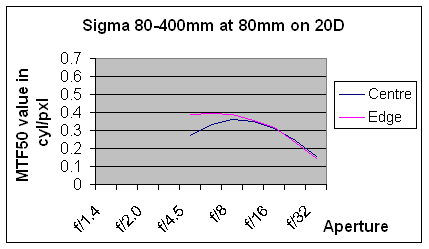
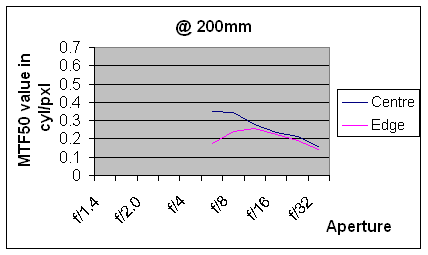
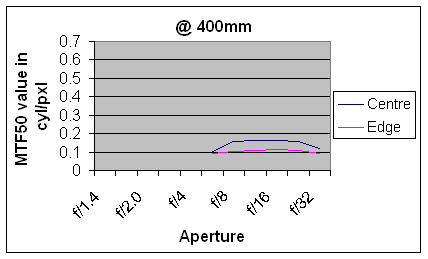
Verdict
This lens produced excellent results at the short end of the zoom range and acceptable ones at the longer end. The OS system worked well, if a little obviously and, like it’s competitors, took a moment to kick in accurately. Once working, it showed well in the viewfinder and gave confidence in using it. The build quality is excellent with a clean matt black finish that is known to be hard wearing and no unwanted play in any of the moving parts. At 2/3rds of the price of it’s competitors, this lens looks to be a good value addition to the kit bag.
In summary, the positive points of the Sigma 80-400mm EX APO DG OS HSM are:
![]() Good build and finish
Good build and finish
![]() Excellent at the shorter focal lengths (and not too bad at full stretch)
Excellent at the shorter focal lengths (and not too bad at full stretch)
![]() OS system works well
OS system works well
![]() Good close focus ability for type.
Good close focus ability for type.
The negative points are:
![]() Some drop off in resolution at longer length.
Some drop off in resolution at longer length.
![]() Large foot doesn’t have Sigma’s excellent QR system.
Large foot doesn’t have Sigma’s excellent QR system.
![]() A little heavier than the opposition
A little heavier than the opposition
Check the latest price for the Sigma 80-400mm EX APO DG OS HSM here
Test by Ian Andrews www.wildaboutkent.co.uk
Add your message
Please login here or if you've not registered, you can register here. Registering is safe, quick and free.
photodo Stats
428 MTF tests
74 in-depth photodo reviews
100+ users join each day
Help the lens community by reviewing or rating a lens today via our lens search
Latest Lens Reviews
- Chinon 28mm f/2.8 Vintage Lens Review
- Canon EF 70-200mm f/4L IS II USM Lens Review
- Samyang AF 85mm f/1.4 EF Review
- Sigma 70mm f/2.8 DG Macro Art Review
- Samyang AF 24mm f/2.8 FE Review
- Meike 50mm f/1.7 Review
- Tamron 70-210mm f/4 Di VC USD Review
- Lensbaby Burnside 35mm f/2.8 Review
- Asahi Super Takumar 50mm f/1.4 Review
- Asahi Super-Multi-Coated Takumar 135mm f/3.5 Review


